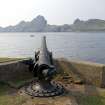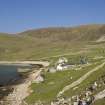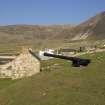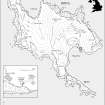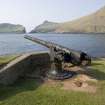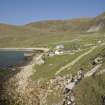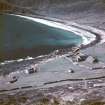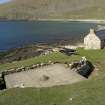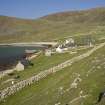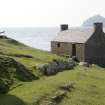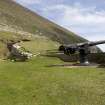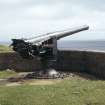St Kilda, Hirta, Village Bay
Gun Emplacement (First World War), Magazine (First World War)
Site Name St Kilda, Hirta, Village Bay
Classification Gun Emplacement (First World War), Magazine (First World War)
Alternative Name(s) Point Of Coll
Canmore ID 214734
Site Number NF19NW 61
NGR NF 10427 99028
NGR Description NT 10427 99028 and NT10442 99028
Datum OSGB36 - NGR
Permalink http://canmore.org.uk/site/214734
- Council Western Isles
- Parish Harris
- Former Region Western Isles Islands Area
- Former District Western Isles
- Former County Inverness-shire
NF19NW 61 10427 99028 and NT10442 99028
(Gun Emplacement NF 10427 99028; Magazine NF 10442 99028)
A steel and concrete built gun-emplacement is situated about 200m SE of the pier at St Kilda village (NF19NW 1). Consisting of one 4-inch gun mounted on a concrete emplacement with a sunken magazine.
The gun and sunken magazine were completed during October 1918 after a bombardment by a U-boat during May 1918.
J Guy 2002; NMRS MS 810/12, 73, 79-80
Construction (August 1918 - October 1918)
Built by a group of St Kildan men led, in the main, by A Nesbit, Chargeman of Bricklayers, HM Dockyard Rosyth.
Note (November 2017)
U-boats among the Hebrides
For those readers that have sat through the 1981 German submarine film Das Boot, the stress and strain of a U-boat life are all too familiar. It is a brilliant expose where the tension and pressure felt by the hull at depth affects not only the crew but the audience as well. No wonder then that U-boat crews would take every opportunity to escape. On 5th June 1918 one particular U-boat stopped off on one of Scotland’s remotest islands (North Rona) to steal seven sheep.
U-90 had an interesting career. Built in Danzig she was launched in January 1917 after more than a year of construction. Some 66m in length, she carried a compliment of 32 men and 4 officers. Between September and November 1918 she undertook seven patrols, and, in May that year, most famously sank the USS President Lincoln, a former German steamship used as a troop transport. U-90 was surrendered on November 1918 and broken up in Bo’ness on the Firth of Forth.
Our interest here, however, are the activities of U-90 two weeks earlier when she nosed into Village Bay, St Kilda, apparently intent on causing damage. St Kilda had been manned as a Naval wireless station since January 1915 with a group of about 15 men stationed there. With the help of the islanders, the crew manned a series of watching stations on the high hills of the islands, and maintained contact with the outer isles reporting on enemy shipping and actions.
In the early hours of the 15th May she approached St Kilda in order to establish whether it was being used as a military base and radio station. As the U-boat surfaced in the bay and the crew manned the deck gun – some 100 people were seen in the village, many of whom fled to the hills behind. After sounding an audible warning, the crew opened fire on what they took to be a power station and barracks near the shore. Their efforts to bring down the masts proved ineffectual and, due to the presence of some armed men, they elected not to land.
The islanders had rather a different experience. While some did indeed run to the hills, and their cattle became mad with distress, others toyed with the idea of rowing out to bargain for tobacco. Damage was considerable – the islander’s storehouse, church and three of their houses, parts of one of the wireless sets, seven military huts, and the nurse’s house (used as wireless office). Of these it was the late 18th century storehouse that was put out of use permanently. Despite the efforts of the owners to recoup compensation, it remained a ruin until the late 1980s when it was restored by the National Trust for Scotland.
Such a blatant attack, one of only 15 on British shores, caused a strong reaction in the Navy. Two patrol vessels were stationed in the bay and carpenters sent out within a month to enact repairs. With armed trawlers overstretched in the area, it was decided to set up a permanent defence and as early as August 1918 construction began on a gun emplacement and a magazine. Working from 6am to 6pm a group of five builders, assisted by the St Kildans, toiled away for much of the next seven weeks and the gun was announced ready for action on 13th October. Armistice was announced a month later.
A Gun that Never Fired
Never having seen action, the gun seems an anachronism on St Kilda. But it is significant in some respects. Firstly, having been set up in such a remote location it remains one of only three examples of in situ World War 1 gun emplacements in Scotland, the others surviving at another remote location at Vementry, Shetland. In contrast, the rich military landscapes on the islands of the Firth of Forth have been stripped almost completely of their military hardware. Secondly, the gun in fact prefigured one of the most significant aspects of the history of St Kilda. After the island was abandoned in 1930 (and the islanders stopped getting any payments for maintenance of the gun) its history became wrapped up with research and nature conservation for a generation. But in 1957 that all changed when the island was chosen as the outer radar station for a vast missile testing range to be established on the Western Isles. In the following two years some 300 airmen constructed a small base with generators, accommodation, radar buildings, workshops, and kitchens. The gun stayed put since it didn’t seem necessary or appropriate to remove it from the island and it became something of an emblem for the military staff and other visitors to the island.
It is also symbolic in another respect. For many writers the occupation of the islands in World War 1 has been seen as a crucial element of the dwindling resolve of the population, and the evacuation of the remaining 36 in 1930. The men of the wireless station brought a wealth of stories from the outside and talked of an easier life, and the station received much better communications than the islanders were used to. The gun acts as a symbol of that dominant theme in St Kildan literature – the nexus between the outside world and the remote island. In fact however, much of the archaeology of the island speaks to the outside world – the church is a design of Thomas Telford, the crofts are a ubiquitous part of the landscape of NW Scotland, even the cleitean speak to the storage of bird products that found a market on the mainland.
Nowadays the gun it is kept spick and span by the dedicated volunteers of the National Trust for Scotland and it survives as an interesting reminder of one short period in the long story of the islands.
Main source: https://canmore.org.uk/collection/1401518
George Geddes, Archaeologist, Survey and Recording, Historic Environment Scotland




















